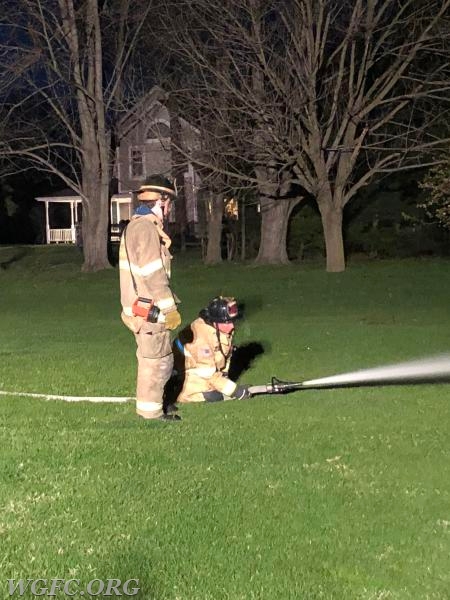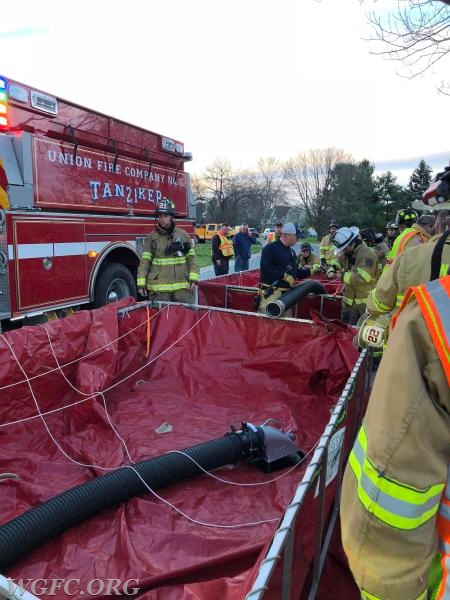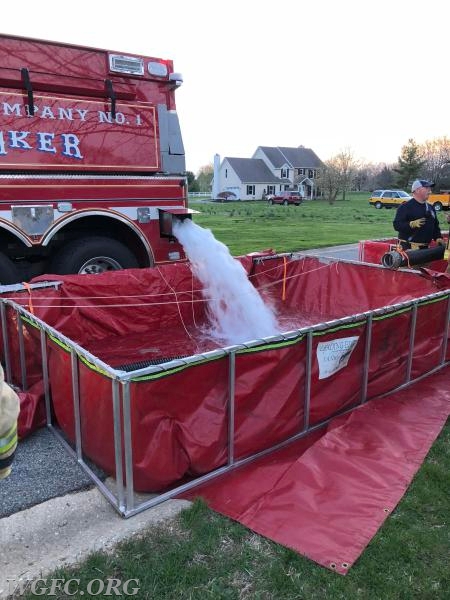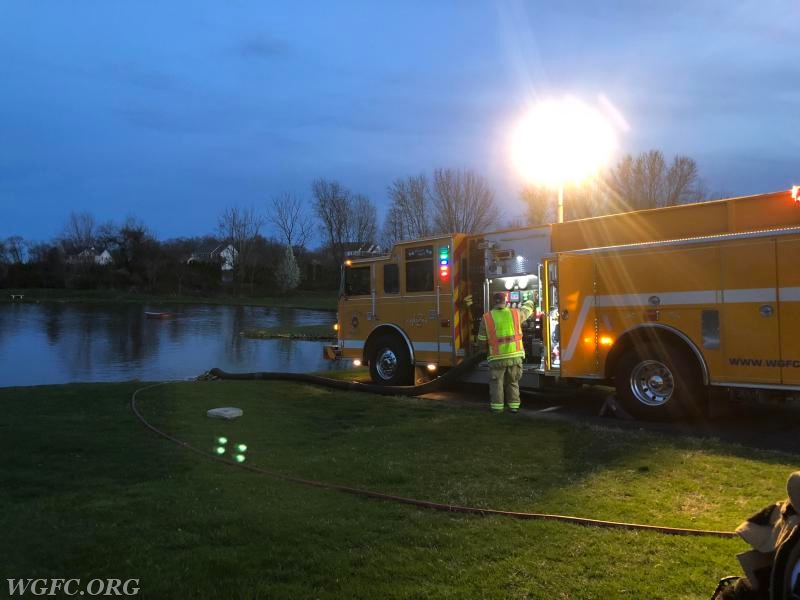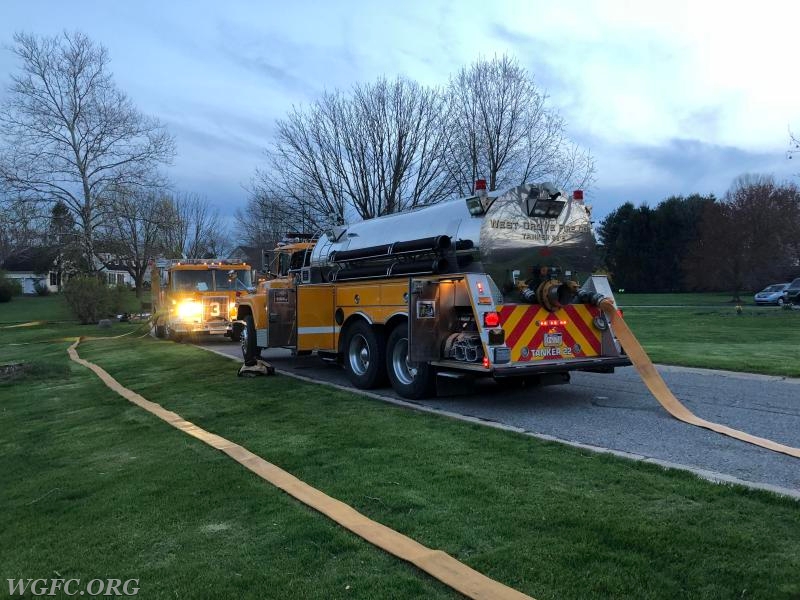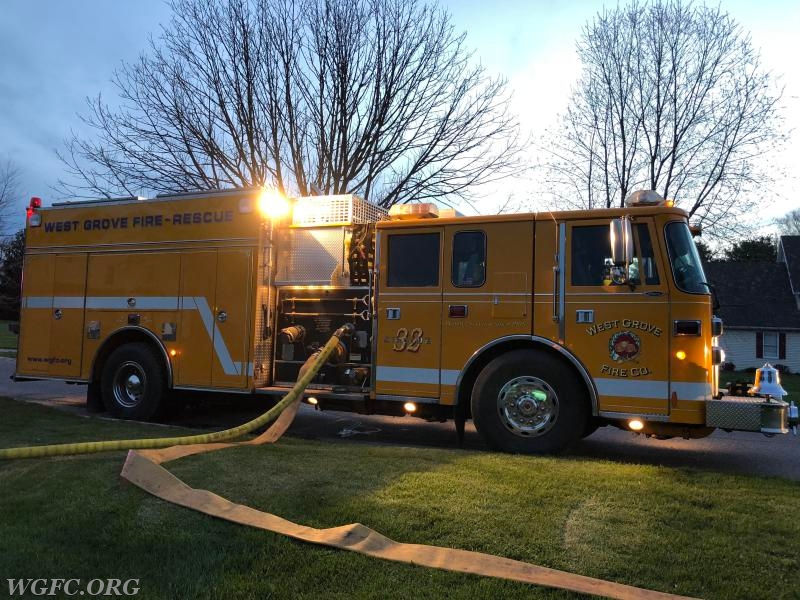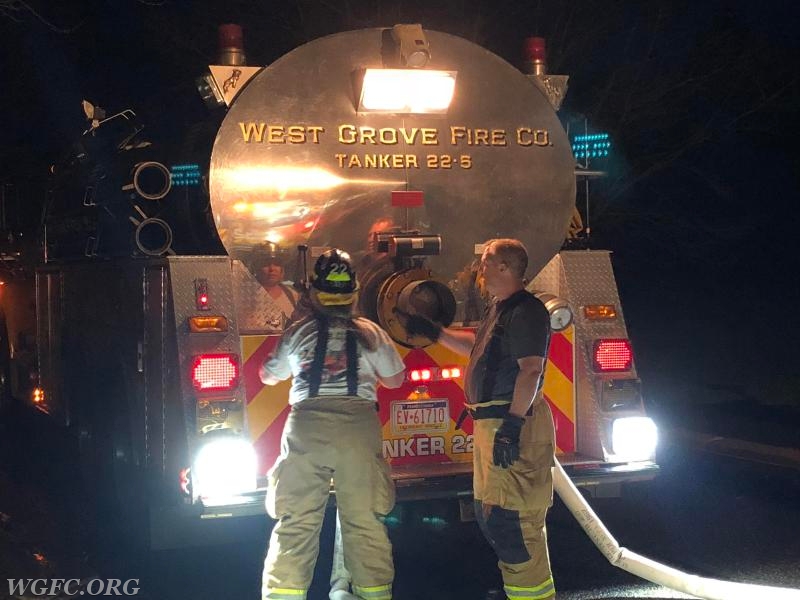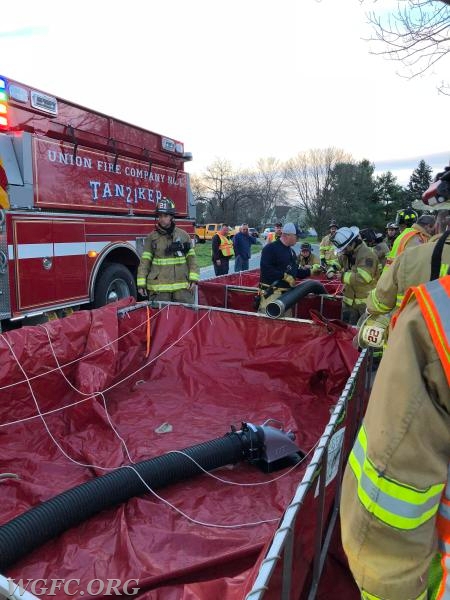| By Secretary Bill Wohl | |
| April 25, 2018 | |
| Nearly 30 volunteers from both the West Grove and Oxford fire companies ran a multi-hour drill in Franklin Township on Monday evening practicing the techniques of rural water supply. The drill was help on Meadow Wood Lane, off of Appleton Road. Fire companies in southern Chester County are often faced with the challenge of having to supply their own water for firefighting, as much of our community remains quite rural, and there are no fire hydrants in many housing developments. As a result, the fire companies maintain apparatus fleets designed to carry enough water to begin a firefighting effort, and then have developed and honed techniques to rapidly supply thousands of gallons rapidly to sustain firefighting over an extended incident. Today's front line fire suppression apparatus normally carry 1000 gallons of water -- each pumper truck at the WGFC does so, supplying pumps that can use 1000 gallons or more in about one minutes time (at full pumping capacity). To provide additional water beyond what is in the first trucks, tanker trucks are used - as West Grove, Tanker 22 arrives with 3000 gallons. Beyond that, the fire company must quickly bring more water to the scene - this is often accomplished by driving to a fire hydrant and refilling tanker trucks who shuttle the water to the scene. Where hydrants are too far, pumpers can be staged at known accessible ponds and draft water for this purpose. Cisterns are also accessible at known locations -- WGFC Station 32 has water underground for this purpose, and a huge private tank sits at Lowes for a similar reason. Water shuttle operations are regularly practiced -- as sustaining a 1000+ gallons per minute water flow is not an easy thing to do, as speed and safety must dictate operations, and water supplies are often not close by. It is not unusual for a large fire to consume 80,000 gallons of water over a few hours, requiring a tanker shuttle of a half dozen tanker trucks on a moments notice. The Monday night drill was designed to give West Grove and Oxford crews a chance to practice a variety of techniques utilized in such a scenario. First, a crew utilizing WGFC Engine 2 was positioned at a pond on Meadow Wood Lane that is available for fire company use. That crew positions the truck at the water's edge, connects four sections of hard sleeve suction hose into the pond, and the truck is then used to draft (or suction) water from the pond and deliver it 500 feet out the driveway in large diameter (5") hose to the road to refill tanker trucks. A multi-function valve and two 2-1/2" hose sections are used to maintain water flow and connect to the two tanker trucks used in this exercise. A second component of the drill is establishing a water drop site. Here, the first arrving tanker -- in this case Tanker 21 from Oxford arrives with 3000 gallons of water. Two portable tanks are removed from Tanker 21 and placed alongside the road. Tanker 21 then dumps all 3000 gallons of water into the portable tank and leaves to get refilled. A pumper truck -- Engine 21-2 from Oxford -- is positioned next to the two portable tanks, and uses its hard sleeve suction hose to draft (suction) water from the portable tanks, and establish a water flow to supply the simulated fire scene. Two portable tanks are utilized, allowing up to 6000 gallons of water to be dumped from multiple tankers at once. Specialized techniques and equipment allow this water to flow between the two tanks, and into Engine 21-2. In a third component of the drill, a supply line from Engine 21-2 to the simulated fire scene. The supply line, in this case, was connected to a new device now in service in both departments Oxford and West Grove. The device, known as a clapper valve, allows two large diameter supply lines to be connected, giving the water supply operation options on maintaining a consistent, high volume flow the the fire scene. For this drill, West Grove tanker supplied water first, while the portable tank operation was established. Once Tanker 22 was empty, the value allows an automatic ability to use the 21-2 system to supply water, without stopping the water flow operation. And, fourth, Engine 22-3 of the WGFC was used to simulate the fire scene. The Engine was receiving a high volume flow from the supply line, getting water first by Tanker 22, and then continuously for 45 minutes from the tanker shuttle. Engine 22-3 operated a high volume portable deluge gun (which flowed water back into the pond) to simulate a fire attack. A hand line was also deployed to add to the water flow drill. The overall goal of this four part training exercise was to give crews the ability to set up, operate and simulate a large volume water supply operation for a large rural fire. Crews got experience in tanker shuttle operations, and experienced the use of the new clapper valves. Crews also were able to practice hose line deployment and pond drafting operations. While all of this played out in practice fashion at a slow pace, these same firefighters are often faced with establishing these four distinct components of a total fire attack in emergency conditions, and must do so without knowing in advance what they will find at any given fire. As such, practice makes it possible to apply known techniques to unpredictable conditions. Our thanks to the residents of Meadow Wood Lane for their cooperation, and particularly to the resident at #7 who maintains a paved driveway to a known fire pond. More than 30 volunteers gave up several hours of their Monday evening for this training exercise - which was very much a success. Clean up and hose repacking were completed by about 10pm Monday evening. |
|
| Units: | Engines 1, 2, and 3, Tanker 22, Ladder 22, Utility 22, Brush 22, Rescue 22 |
| Mutual Aid: | Tanker 21, Engine 21-2 |
